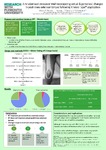A randomised crossover trial investigating actual and perceived changes in peak knee extensor torque following Kinesio Tape® application.
| dc.contributor.author | Walsh, E | |
| dc.contributor.author | Barrett, J | |
| dc.contributor.author | Beeson, J | |
| dc.contributor.author | Zammit, M | |
| dc.contributor.author | Rickard, Alec | |
| dc.date.accessioned | 2017-12-19T15:45:26Z | |
| dc.date.available | 2017-12-19T15:45:26Z | |
| dc.date.issued | 2017-11-10 | |
| dc.identifier.uri | http://hdl.handle.net/10026.1/10444 | |
| dc.description | Also presented by E. Walsh as a "Rapid 5" presentation at the conference | |
| dc.description.abstract |
Abstract: Background: The application and use of Kinesio tape® (KT) has become increasingly popular over the last decade. Previous studies investigating the effect of KT on strength at the knee have provided inconclusive results, and have highlighted the potential for KT to have a placebo effect. Aim: The primary aim investigated the correlation between actual and perceived change in peak knee extensor torque following KT application. The secondary aim sought to determine the extent to which KT improves peak knee extensor torque. Methods: A randomised crossover, placebo controlled design was used. A convenience sample of 36 healthy adults between 18-30 years of age were recruited via email. The three conditions investigated included no tape, acting as a baseline measure, followed by KT and sham tape in a randomised order. Outcome measures included the isokinetic dynamometer to measure peak knee extensor torque at 180°/s and the Global Rating of Change Scale (GRCS) to measure participants’ perception of strength. Results/Findings: No significant correlation was identified between actual and perceived peak knee extensor torque following KT application (P = 0.408). The majority of participants (56%) perceived their strength to have improved following KT. The secondary aim found a significant decrease in peak knee extensor torque after KT compared to no tape (P = 0.005), with no statistical difference when KT was compared to sham tape (P = 0.975). Conclusion: The findings of this study indicate that there is no relationship between participants’ actual strength and their perception of strength following the application of KT. The results of this study do not support the use of KT to improve peak knee extensor torque. | |
| dc.language.iso | en | |
| dc.subject | Kinesio tape | |
| dc.subject | K-tape | |
| dc.subject | extensor torque | |
| dc.subject | knee | |
| dc.subject | tape | |
| dc.title | A randomised crossover trial investigating actual and perceived changes in peak knee extensor torque following Kinesio Tape® application. | |
| dc.type | presentation | |
| plymouth.organisational-group | /Plymouth | |
| plymouth.organisational-group | /Plymouth/Faculty of Health | |
| plymouth.organisational-group | /Plymouth/Users by role | |
| plymouth.organisational-group | /Plymouth/Users by role/Academics | |
| dc.rights.embargoperiod | Not known | |
| rioxxterms.licenseref.uri | http://www.rioxx.net/licenses/all-rights-reserved | |
| rioxxterms.type | Other |


